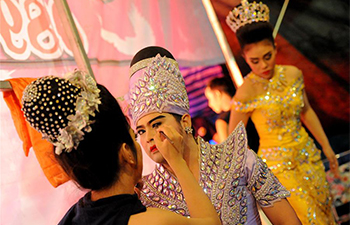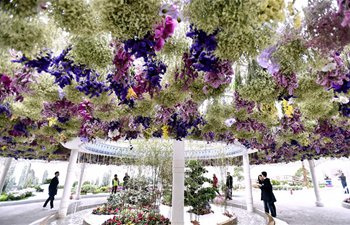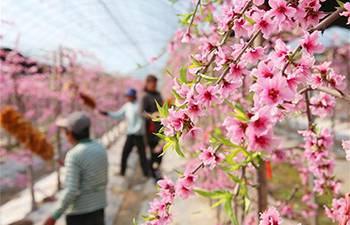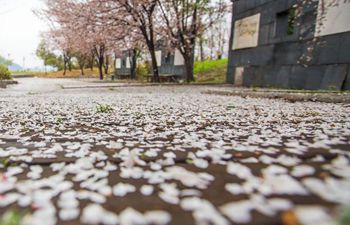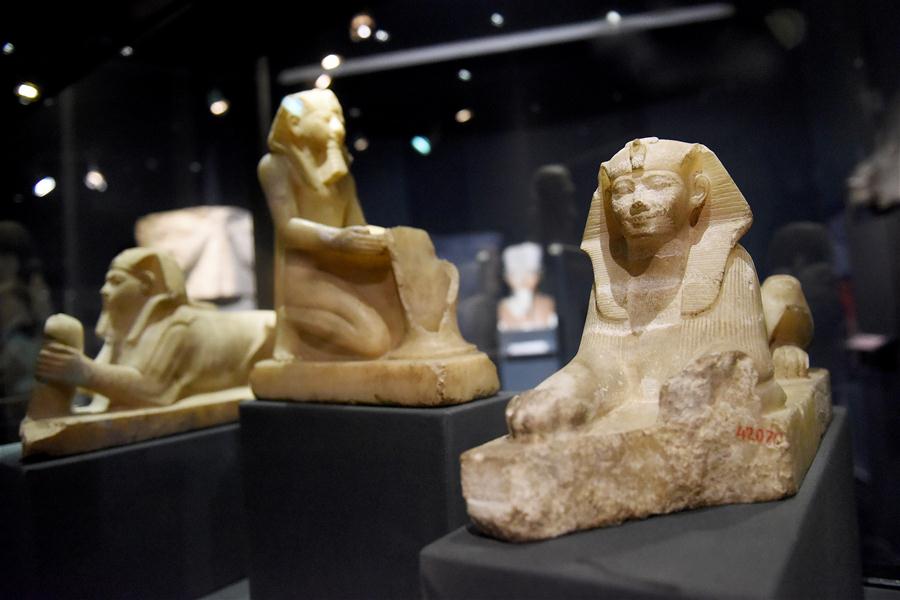
Artifacts from the Pharaonic time are displayed at the Alexandria National Museum in Alexandria, Egypt, on March 12, 2018. Alexandria National Museum, containing some 1,800 priceless Pharaonic, Greco-Roman, Islamic and Coptic artifacts that narrate the story of the Mediterranean historical city of Alexandria north of the capital Cairo, was opened for the public in 2003. (Xinhua/Zhao Dingzhe)
by Mahmoud Fouly
ALEXANDRIA, Egypt, March 18 (Xinhua) -- Ever heard of Alexandria National Museum in Egypt? It's little known, even to Egyptians, but it is really a rare treasure containing some 1,800 priceless Pharaonic, Greco-Roman, Islamic and Coptic artifacts that narrate the story of the Mediterranean historical city of Alexandria north of the capital Cairo.
Located in the busy Horreya Street in downtown Alexandria, the museum looks like a secluded but elegantly-designed three-storey white palace. The classic building once belonged to a wealthy Lebanese-born wood merchant who sold it to the consulate of the United States in 1954 before Egypt's Supreme Council of Antiquities (SCA) bought it in 1996 to turn it into a museum.
Alexandria National Museum was opened for the public in 2003, hosting artifacts of all historical events from the Pharaonic dynastic times, passing through the Ptolemaic Kingdom, the Roman Empire, the Byzantine and Islamic periods until the beginning of Mohammed Ali's era as Egypt's ruler and finally the Egyptian anti-British 1952 revolution.
After ascending front porch steps and crossing the gate to the main hallway, a visitor faces a standing Roman-style marble statue of a matron-like woman wrapped in a detailed garment. That statue marks the starting point of a tour inside the museum based on the visitor's choice.
The main floor containing the statue hosts the Greco-Roman artifacts, while the basement contains ancient Egyptian Pharaonic antiquities and the upper floor exhibits Islamic, Coptic and modern age artifacts.
"The oldest antiquities we have here are those of the Old Kingdom of the Pharaonic era, dating back 5,000 to 6,000 years. Most of Alexandria artifacts are Greek and Roman, so we brought the Pharaonic artifacts from various museums in Cairo and Upper Egypt," Ahmed Tawfik, the museum's manager, told Xinhua at the main entrance.
He added that the frequency of visitors to the museum increased over the past couple of years, hoping for more popularity of such a house of rare historical objects.
In the 1990s, beneath the eastern harbor area of Abu Qir Bay in Alexandria, Egypt discovered the sunken city of Cleopatra, an Egyptian ancient queen of Greek Macedonian descent who drove the merge of the Pharaonic and Greek cultures in ancient Egypt.
Last November, the SCA announced the discovery of three shipwrecks dating back to the Roman era on the seabed of northern coastal province of Alexandria.
"What's so unique about the Greco-Roman section is the hall of sunken antiquities, which have been picked up from the eastern harbor area of Abu Qir Bay. A large group of them are currently in a foreign exhibition in some Western states," said the museum's manager.
Alexandria city is named after Alexander the Great who succeeded his father as king of Macedonia and started in 334 B.C. a long military campaign against the Persian Empire where he conquered Egypt and declared himself as king. He was welcomed by the Egyptians, especially because he declared himself as son of the ancient Egyptian god Amun.
The Greco-Roman section exhibits statues, objects and paintings dating back to Alexander's era, including a basalt head of a Ptolemaic king, a large upper part of a statue representing Alexanderia's official god Serapis, a bust of Emperor Caracalla wearing Pharaonic head dress with a cobra serpent on the top, a mosaic painting of gorgon Medusa, a mythological figure in the Greco-Roman period, and many others.
The Greco-Roman section also includes works from the Hellenistic period such as pieces from Heraklion and Canopus.
A group of young people, who have been touring the museum, expressed admiration of the methods of display, guidelines and organization of the museum sections and objects that make visitors enjoy them all without confusion or distraction.
"I am very happy with the way of exhibition used in the museum. The movement inside the museum is also so smooth that it makes a visitor tour it all without getting lost or missing anything," Ola Mahmoud, an assistant professor at a college of applied arts, told Xinhua at the dim-lit Pharaonic section in the basement.
As for the Pharaonic section, it displays items from the old, middle and new kingdoms of ancient Egypt. The most distinguished masterpieces featured in the section are an alabaster statue of King Mankaure (or Menkaure), the builder of the third pyramid on the Giza Plateau, a head of a sandstone statue of Akhenaton and a head of a painted limestone statue of Queen Hatshepsut.
"We have a distinguished part in this section, which is a model of a tomb with a real mummy inside. This part attracts adults and children, Egyptians and foreigners, alike, because mummification remains an unknown secret lying with ancient Egyptians," Rasha Ali, the Pharaonic section's curator.
"Ancient Egyptians believed in body mummification after death to preserve it for use in the afterlife. This is why they placed a mask on the mummy's head to help the soul recognize it according to their belief," she told Xinhua.
The third floor contains antiquities of the Coptic art including icons of Jesus, the Virgin Mary and the Last Supper as well as tombstones and outfits decorated with golden and silver crosses.
One of the third floor's showrooms exhibits a rare collection of Byzantine and Islamic gold and silver coins minted in Alexandria, as well as a collection of coins known as "the coins of Napoleon's naval fleet" that were salvaged from the waters of Abu Qir Bay.
Lina Mohamed, a college student of sculpture, said that it was her first time to visit Alexandria National Museum and that she would recommend it to everyone.
"I liked most how the hall designs suited the exhibited artifacts. The Pharaonic section in the basement is dim-lit to go with the atmosphere of tombs, the Greco-Roman section has light walls to go with the marble and granite statues and the third floor was medium lit to suit the objects of pottery, textile and coins," she said.







